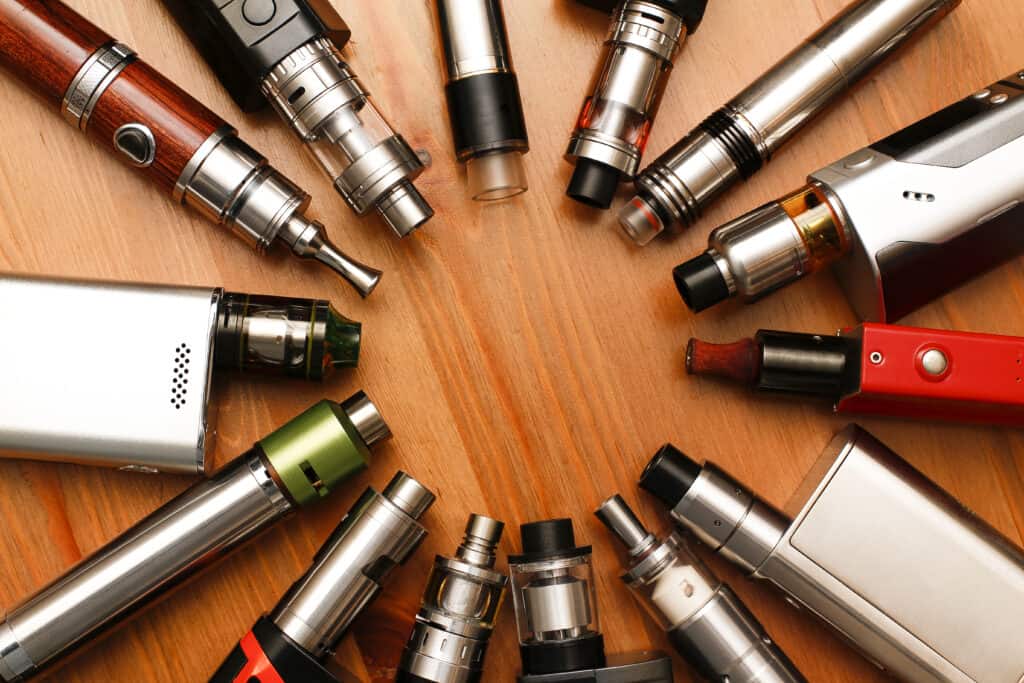By: National Institute on Drug Abuse (NIDA)
NIH-supported study also found past-month vaping levels rebound after early pandemic drop.
Historic Highs in Past-Year Marijuana and Hallucinogen Use Among Young Adults (Ages 19-30) in 2021. Graph displays percentage prevalence of past-year marijuana and hallucinogen use among young adults, ranging from 0% – 50% from years 2011 to 2021, as reported by the 2021 Monitoring the Future panel survey. From 2011 to 2014, past-year marijuana use maintained slightly below to slightly above 30%. Starting from 2014, past-year marijuana use steadily increased without decline in young adults. From 2011 to 2021, past-year marijuana use increased by 13.2% in total. Graph also displays hallucinogen use from 2011 to 2021, during which the percent prevalence of past-year hallucinogen use among young adults ages 19-30 increased from 3.4% in 2011 to 8.1% in 2021 (a total increase of 4.7%). Past-year hallucinogen use had been relatively stable over the past few decades until 2020, when reports of use started to increase dramatically.
Marijuana and hallucinogen use in the past year reported by young adults 19 to 30 years old increased significantly in 2021 compared to five and 10 years ago, reaching historic highs in this age group since 1988, according to the Monitoring the Future (MTF) panel study. Rates of past-month nicotine vaping, which have been gradually increasing in young adults for the past four years, also continued their general upward trend in 2021, despite leveling off in 2020. Past-month marijuana vaping, which had significantly decreased in 2020, rebounded to pre-pandemic levels in 2021.
Alcohol remains the most used substance among adults in the study, though past-year, past-month, and daily drinking have been decreasing over the past decade. Binge drinking (five or more drinks in a row in the past two weeks) rebounded in 2021 from a historic low in 2020, during the early stages of COVID-19 pandemic. On the other hand, high-intensity drinking (having 10 or more drinks in a row in the past two weeks) has been steadily increasing over the past decade and in 2021 reached its highest level ever recorded since first measured in 2005.
“As the drug landscape shifts over time, this data provides a window into the substances and patterns of use favored by young adults. We need to know more about how young adults are using drugs like marijuana and hallucinogens, and the health effects that result from consuming different potencies and forms of these substances,” said National Institute on Drug Abuse Director Nora Volkow, M.D. “Young adults are in a critical life stage and honing their ability to make informed choices. Understanding how substance use can impact the formative choices in young adulthood is critical to help position the new generations for success.”
Since 1975, the Monitoring the Future study has annually surveyed substance use behaviors and attitudes among a nationally representative sample of teens. A longitudinal panel study component of MTF conducts follow-up surveys on a subset of these participants to track their drug use through adulthood. Participants self-report their drug use behaviors across three primary time periods – lifetime, past year (12 months), and past month (30 days). The MTF study is conducted by scientists at the University of Michigan’s Institute for Social Research, Ann Arbor, and is funded by NIDA, part of the National Institutes of Health.
Data for the 2021 survey were collected online from April 2021 through October 2021. Key findings in the young adult group include:
Marijuana Use: Past-year, past-month, and daily marijuana use (use on 20 or more occasions in the past 30 days) reached the highest levels ever recorded since these trends were first monitored in 1988. The proportion of young adults who reported past-year marijuana use reached 43% in 2021, a significant increase from 34% five years ago (2016) and 29% 10 years ago (2011). Marijuana use in the past month was reported by 29% of young adults in 2021, compared to 21% in 2016 and 17% in 2011. Daily marijuana use also significantly increased during these time periods, reported by 11% of young adults in 2021, compared to 8% in 2016 and 6% in 2011.
Hallucinogen Use: Past-year hallucinogen use had been relatively stable over the past few decades until 2020, when reports of use started to increase dramatically. In 2021, 8% of young adults reported past-year hallucinogen use, representing an all-time high since the category was first surveyed in 1988. By comparison, in 2016, 5% of young adults reported past-year hallucinogen use, and in 2011, only 3% reported use. Types of hallucinogens reported by participants included LSD, MDMA, mescaline, peyote, “shrooms” or psilocybin, and PCP. The only hallucinogen measured that significantly decreased in use was MDMA (also called ecstasy or Molly), showing statistically significant decreases within one year as well as the past five years – from 5% in both 2016 and 2020 to 3% in 2021.
Vaping: Nicotine vaping in the past month increased significantly among young adults in 2021 despite leveling off in 2020 during the earlier part of the pandemic. The continued increase in 2021 reflects a general long-term upward trend: in 2021, nicotine vaping prevalence nearly tripled to 16% compared to 6% in 2017, when the behavior was first recorded.
Prevalence of marijuana vaping in the past month among young adults had significantly dipped in 2020 but returned to near pre-pandemic levels in 2021. Since 2017, when marijuana vaping was included in this study, past-month prevalence has doubled – from 6% in 2017 to 12% in 2021.
Alcohol Use: Reports of binge drinking by young adults – defined as having five or more drinks in a row in the past two weeks – returned to pre-pandemic levels in 2021 after significantly decreasing in 2020 (32% reported in 2021, versus 28% in 2020 and 32% in 2019). High-intensity drinking, defined as having 10 or more drinks in a row in the past two weeks, was at its highest level since it was first measured in 2005, reported by 13% of young adults in 2021, compared with 11% in 2005. However, past-month and past-year alcohol use, and daily drinking have been on a downward trend in young adults for the past 10 years. For example, in 2021, 66% of young adults reported alcohol use in the past 30 days, a significant decline from 70% recorded in 2016 and 69% in 2011.
The study also showed significant decreases in past-month cigarette smoking by young adults and non-medical use of opioid medications in the past year (surveyed as “narcotics other than heroin”) compared to 10 years ago. Both substances have been declining steadily in use for the past decade. Additional data from the 2021 MTF panel study include drug use reported by adults 35 to 50 years old, college/non-college young adults, and among various demographic subgroups.
“One of the best ways we can learn more about drug use and its impact on people is to observe which drugs are appearing, in which populations, for how long, and under which contexts,” said Megan Patrick, Ph.D., a research professor at the University of Michigan and principal investigator of the MTF panel study. “Monitoring the Future and similar large-scale surveys on a consistent sample population allow us to assess the effects of ‘natural experiments’ like the pandemic. We can examine how and why drugs are used and highlight critical areas to guide where the research should go next and to inform public health interventions.”
View more information on the methods behind MTF panel study data collection and how the survey adjusts for the effects of potential exclusions in the report.
Results from the related 2021 MTF study of substance use behaviors and related attitudes among teens in the United States was released in December 2021, and 2022 results are upcoming in December 2022.
For more information on substance and mental health treatment programs in your area, call the free and confidential National Helpline 1-800-662-HELP (4357) or visit www.FindTreatment.gov.
National Institute on Drug Abuse (NIDA). (August 2022). Marijuana and hallucinogen use among young adults reached all time-high in 2021. Retrieved from https://nida.nih.gov/news-events/news-releases/2022/08/marijuana-and-hallucinogen-use-among-young-adults-reached-all-time-high-in-2021
National Institutes of Health (NIH). (August 2022). Marijuana and hallucinogen use among young adults reached all time-high in 2021. Retrieved from https://nida.nih.gov/news-events/news-releases/2022/08/marijuana-and-hallucinogen-use-among-young-adults-reached-all-time-high-in-2021





